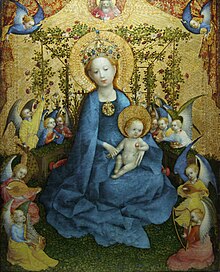Hortus conclusus

The Hortus conclusus (Latin for closed or closed garden) is a pictorial theme or an immanent pictorial motif of the visual arts and plays a special role in the symbolism of Mary .
Origins
The motif of the Hortus conclusus goes back to an interpretation of the Song of Songs in the Old Testament . There it says:
- My sister, dear bride, you are a closed garden, a closed spring, a sealed fountain ( Hld 4,12 LUT ).
This symbolism also appears in various visions of mystics , for example in the Mariale of the abbot of Perseigne , in which the Virgin Mary is compared with a closed garden . There, white Madonna lilies symbolize her virginity and the thornless rose her inexhaustible mercy.
iconography
Many paintings of the Virgin Mary show a fenced-in garden that indicates the Hortus conclusus . In this garden plants are regularly depicted that - like the Madonna lily and the thornless rose - are also related to Mary:
photos
A well-known, but inconclusive and broken representation of the Hortus conclusus is the so-called Paradiesgärtlein , which was created around 1410 and comes from the Upper Rhine master . It shows Mary in a walled garden, surrounded by angels and saints . The hortus conclusus is often only hinted at. In Jan van Eyck's Madonna of Chancellor Nicholas Rolin , only the wall in the background and the little garden in front of it with roses, irises and lilies point to the motif of the Hortus conclusus. When Stuppacher Madonna of Matthias Grünewald , it is the closed gates, which creates the reference to it. References to the Hortus conclusus are also evident in Stefan Lochner's Madonna im Rosenhag .
The choir ceiling in the crossing of the Church of St. Nicholas and the Visitation of the Virgin Mary in Arnstein-Büchold , which can be understood as a “hortus conclusus”, shows 180 plants on 50 plant fields and those with a clear reference to Mary in liturgically or architecturally significant places.
Church patronage
In the pilgrimage site of Warfhuizen in the Netherlands, the hermitage of Our Lady of the Closed Garden is dedicated to the Virgin Mary .
Contemporary interpretations
The Serpentine Gallery pavilion in 2011 was designed by the Swiss architect Peter Zumthor as an interpretation of the Hortus conclusus theme. Cut off from the outside world, he designed a garden that encouraged contemplative lingering. In 2007 the sculptor Nele Ströbel showed an exhibition in the Diözesanmuseum Paderborn with the title "Hortus conclusus - a spiritual space becomes a picture" and since 2014 the artist Claudia Starkloff has devoted herself to the picture motif in various time-based works.
See also
Web links
- "Hortus conclusus", the Janus face of the garden in the Middle Ages , by Christina Steinmetzer (from the lecture series of the University of Salzburg in the winter semester 2001/2002; PDF file; 257 kB)
- On the meaning of the "Hortus conclusus" symbolism in cultural history
Individual evidence
- ↑ Wolfgang Schiedermair, Franz-Christian Czygan , Gundolf Keil : Thoughts on the symbolism of plants in a Lower Franconian church. The choir of the Bücholder parish church St. Nikolaus and Mariae Heimsuchung as an independent part of the iconographic concept of the church. In: Mainfränkisches Jahrbuch. Volume 60, 2008, pp. 99-115.
- ↑ Wolfgang Schiedermair: The "Meelbyrn, Paliurus" in Adam Lonitzer's "Kreuterbuch" (1679). For knowledge of X Sorbopyrus auricularis (Kroop.) Schneid. - Rose hip pear. In: Medical historical messages. Journal for the history of science and specialist prose research. Volume 34, 2015 (2016), pp. 87–96, here: pp. 87 f.
- ↑ See also Werner Dressendörfer: The sky garden on the ceiling of St. Michael with a map for 100 plants. Leader. 2nd Edition. Bamberg 1995.

